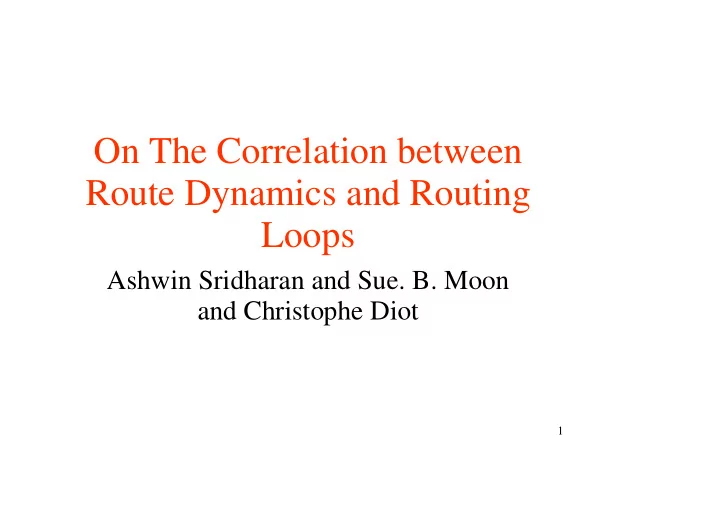

On The Correlation between Route Dynamics and Routing Loops Ashwin Sridharan and Sue. B. Moon and Christophe Diot 1
Problem Statement • Identify possible causes of routing loops within the Sprint backbone. – Methodology to correlate loops detected in traffic traces with routing events. – Any dominant cause(s) ? – Analyze impact of routing events on loop characteristics. 2
Talk Layout • Routing Loops – Classification, causal sources. • Methodology – Collection of data – Detection of loops and correlation with events. • Analysis of data – Contribution of various protocols to loop creation. – Effectiveness of detection technique. – Effect of updates on path length distribution. • Conclusions 3
Routing Loops • Finite speed of propagation causes loops. – Routers change state in reaction to event. – After update, they broadcast new state. – Routing protocols have non-zero convergence time – BGP and ISIS routing protocols within Sprint. • Can be classified based on cause/duration. – Transient: occur in normal state of operation. – Persistent: typically associable to anomalies. 4
An ISIS Loop R3 9 4 Flow 1 2 1 R1 R2 10 1 2 4 3 3 R4 R5 4 5
A BGP Loop AS Z AS X 4 3 AS Y 5 1 6 2 Customer changes Initially AS X is Customer preference to AS Y preferred Path 6
Methodology • Collection of data. – Packet Traces. – Routing traces. • Detection of packet loops in traces. – [Hengartner et al.] • Correlation of packet loops with routing events. – Correlation with BGP events. – Correlation with ISIS events. 7
Collection of Data • Collected OC-48 traces from 6 backbone links using Sprint IPMON equipment. – Dumps first 44 bytes from each packet. – Timestamps packet using GPS. • BGP updates collected via Zebra BGP daemon peering with a BGP router. • Pyrt ISIS routing daemon creates adjacency with an ISIS router and collects LSPs. 8
Detecting Packet Loops Chunk Packet Stream Hash Buckets Differ only in TTL and Checksum Packet Loops 9
Correlating packet loops and BGP Events • Feed BGP updates to a Zebra router emulating the BGP decision process. • For each BGP update – Determine changes in next-hop or AS Path for any loop. – If change in vicinity of loop origin, assume event responsible for loop. 10
Correlating packet loops and ISIS Events • After each LSP is received, compute shortest path from observation node to all destinations. • For each packet loop – Determine any change in forwarding path. – Determine if it overlaps with previous path. – If event in vicinity of loop, assume event was causal in the creation of the loop. 11
Analysis of Data • Do both protocols cause routing loops ? – All loops in traces associable only with BGP updates. • Link state protocols have fast convergence time. • Extensive use of multiple equal cost paths prevents overlap of ISIS forwarding path. – Monitored links were inter-POP links. 12
Analysis of Data – (2) • How effective is the detection technique ? – Affected by “distance” of source from observation point. – Updates related to events in other Ases may get filtered out. 13
Matching Efficiency Trace % Transient % Persistent % Persistent Total & BGP & BGP & no Updates Updates Updates NYC-20 40.1 0 50.8 90.8 NYC-21 80.2 0 7.5 87.9 NYC-22 18.8 0 80.6 99.4 NYC-23 3.3 0 0 3.3 NYC-24 70.0 0 0 70.0 NYC-25 43.7 15.5 0 59.2 14
Average AS Path Length Trace Avg. AS Path Length NYC-20 1.34 NYC-21 1.04 NYC-22 0.51 NYC-23 1.74 NYC-24 1.61 NYC-25 1.63 15
16
Impact of BGP updates on loop length • Path Length defined as the number of hops in a loop. • Relationship between path length distribution and BGP updates. – If updates impacts large set of destinations, more likely that path length distribution has a higher variance. 17
18
19
20
21
Conclusions • Methodology to correlate routing events with packet loops. • BGP updates were almost exclusively responsible for routing loops. • No loop creation event directly associable with ISIS. – Attributable to equal cost multiple paths. • Correlation between BGP updates and path length distribution. 22
Recommend
More recommend